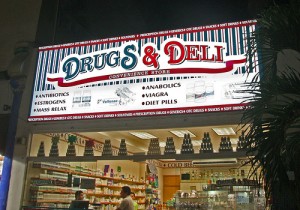 The Family Sarasohn-Kahn is sailing on the Caribbean this week for a long-overdue winter break. Imagine my surprise and ironic delight when at our port this morning we happened onto a storefront called, “Drugs & Deli.” Inside, there’s the usual combination of barcodes that are the hallmark of convenience stores: Pringles, Gatorade, candy, gum, and since we’re on the sea, sunscreen.
The Family Sarasohn-Kahn is sailing on the Caribbean this week for a long-overdue winter break. Imagine my surprise and ironic delight when at our port this morning we happened onto a storefront called, “Drugs & Deli.” Inside, there’s the usual combination of barcodes that are the hallmark of convenience stores: Pringles, Gatorade, candy, gum, and since we’re on the sea, sunscreen.
But there’s another product group sold here in a very retail way: prescription drugs. The décor tells the story: while the name of the store tells the headline, the interior of the shop screams the storyline. Above our heads there are block lettered names of what are popular Rx requests this port pharmacist gets from sailors and passers-by — Lasix, Prilosec, Augmentin, Viagra, et. al. This is retail health pharmacy on, pardon me, steroids (and, yes, see the storefront sign in the photo and note the shop also sells anabolic steroids with your Hawaiian Tropic SPF).
The consumer can walk right to the pharmacist and request an Rx on-the-spot for these drugs and others not mentioned in the ceiling’s border menu.
While named “Drugs & Deli,” I saw more availability of prescription drugs than turkey breast and honey baked ham.
Health Populi’s Hot Points: Is “Drugs & Deli” the shape of things to come U.S. stateside? In my presentations, I’ve often used a New Yorker cartoon titled “Gas ‘N Healthcare” for many years (the New Yorker being a prime source for insights into health care culture, economics and policy in the U.S.). Chain pharmacies are morphing into health providers with on-site clinics, health checks, and of course, growing aisles of over-the-counter products complementing the behind-the-counter Rx’s. Chain discounters like Walmart and Target are health destinations, also expanding health-ful food offerings to add to health care products; and, of course, retail health extends into doctor’s offices and hospital clinics, some of whom are re-imagining what it means to be a health provider for ambulatory care with more accessible front-ends like on-line scheduling, electronic patient records, and use of secure email for patient access and online nurse consultations.
What about pharmacies morphing into an accessible extension of the medical home? This is certainly worth considering when forming both accountable care organizations and patient-centered medical homes in primary care. The community pharmacy and professional pharmacy can help bolster medication adherence, along with providing accessible counseling on the patient’s home/community turf.
Perhaps “Drugs & Deli” isn’t so far-fetched after all?




 Thank you, Jared Johnson, for including me on the list of the
Thank you, Jared Johnson, for including me on the list of the  I am so grateful to Tom Lawry for asking me to pen the foreword for his book, Health Care Nation,
I am so grateful to Tom Lawry for asking me to pen the foreword for his book, Health Care Nation,  Thanks to Feedspot for naming this blog, Health Populi, as a
Thanks to Feedspot for naming this blog, Health Populi, as a